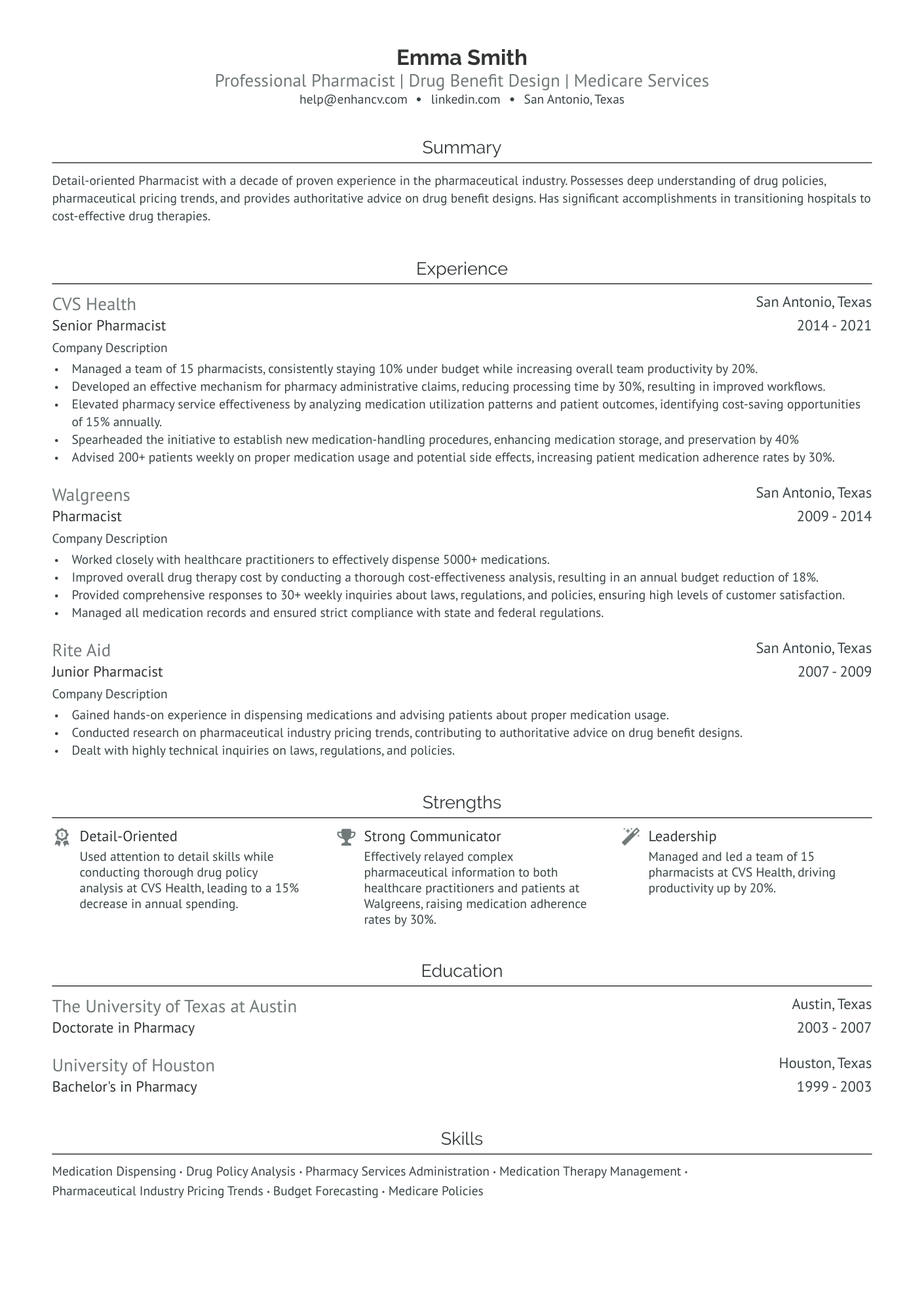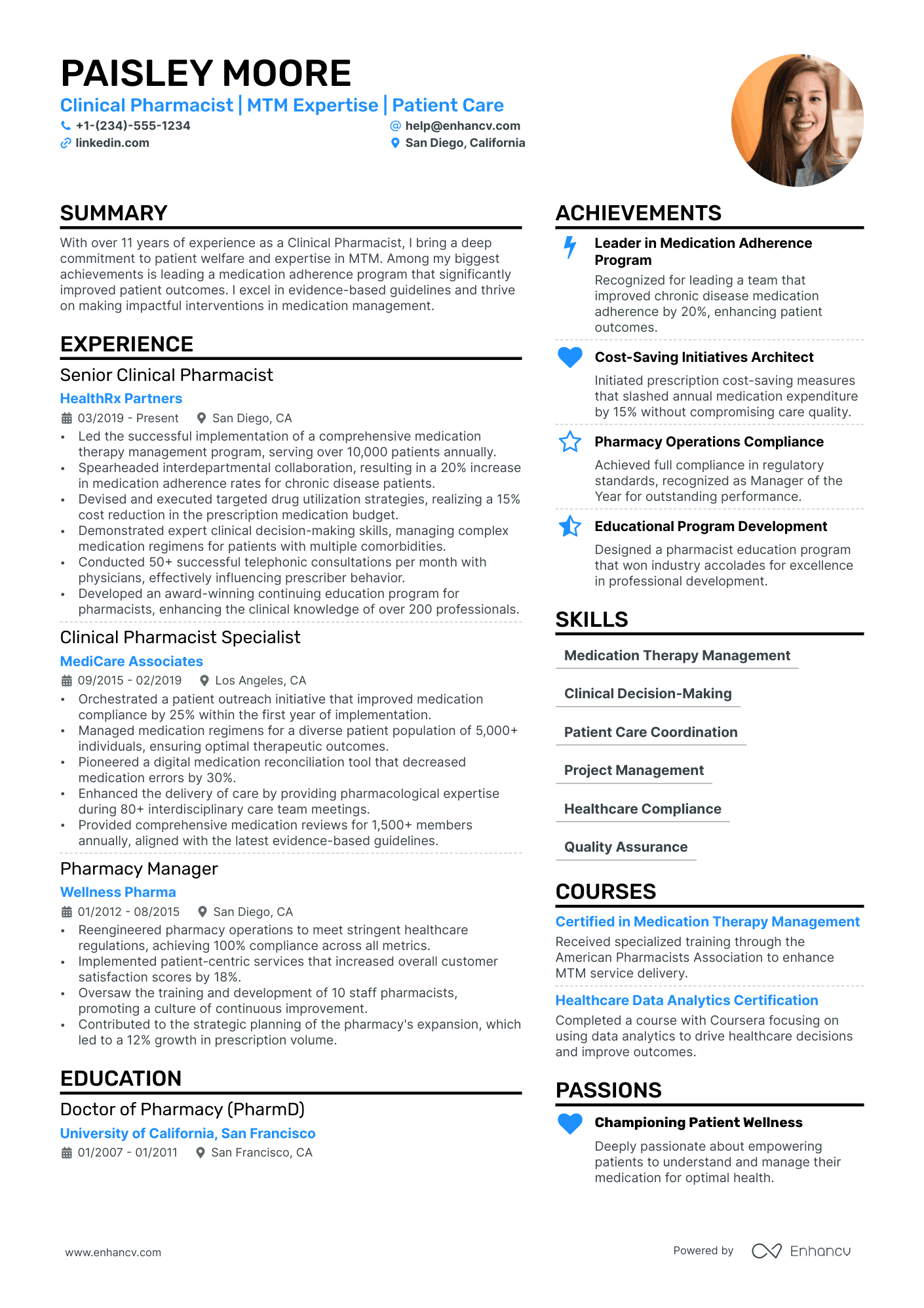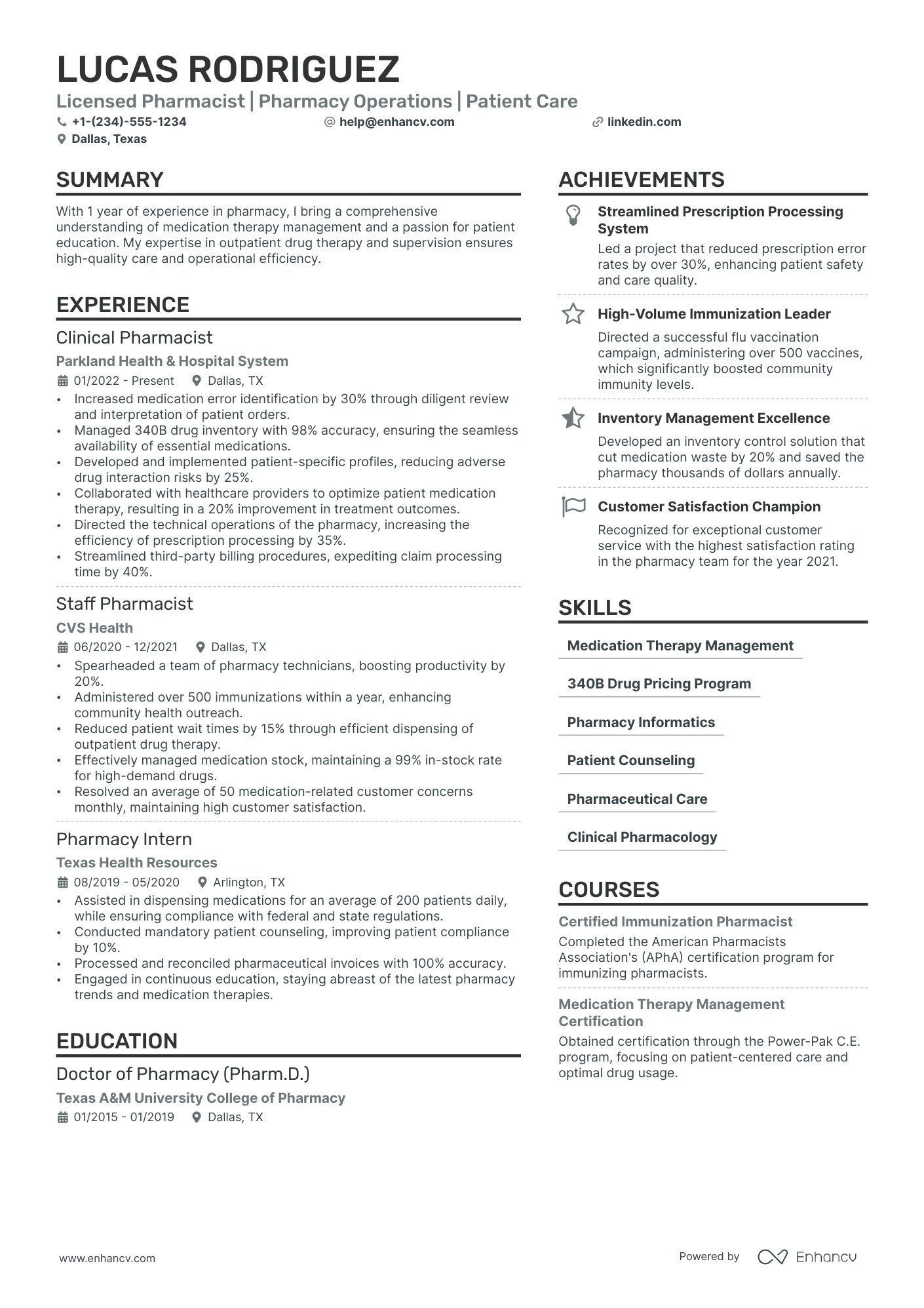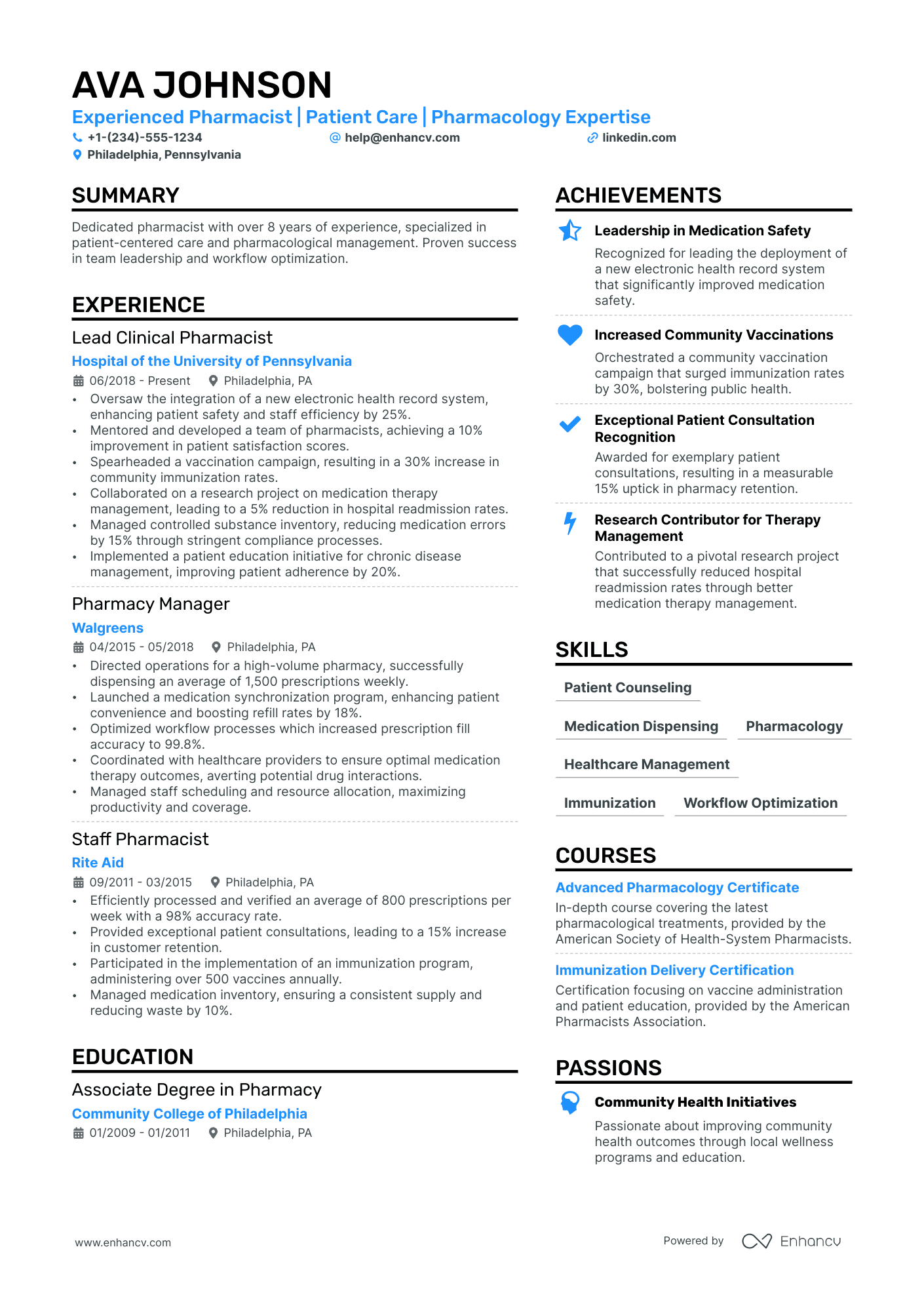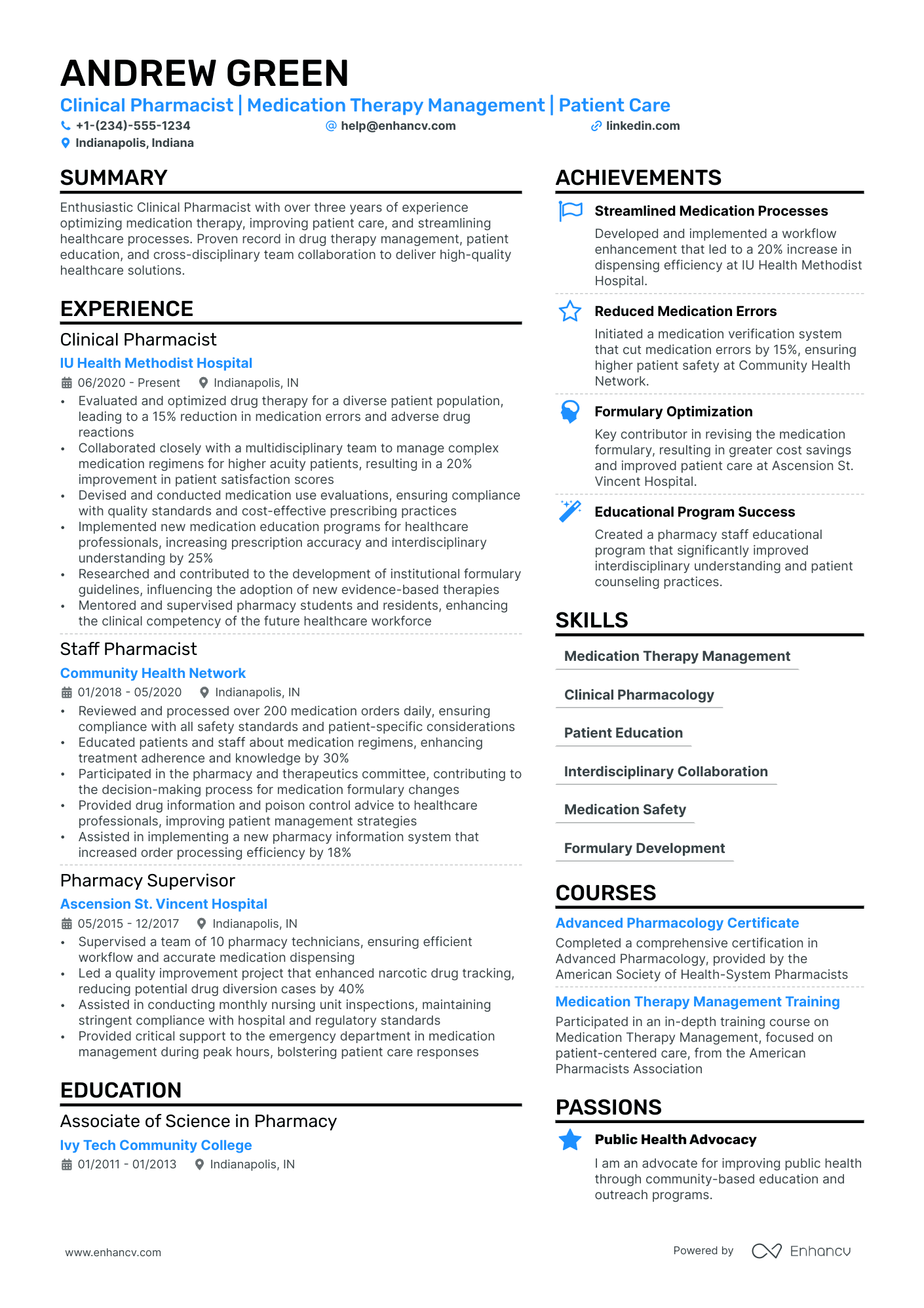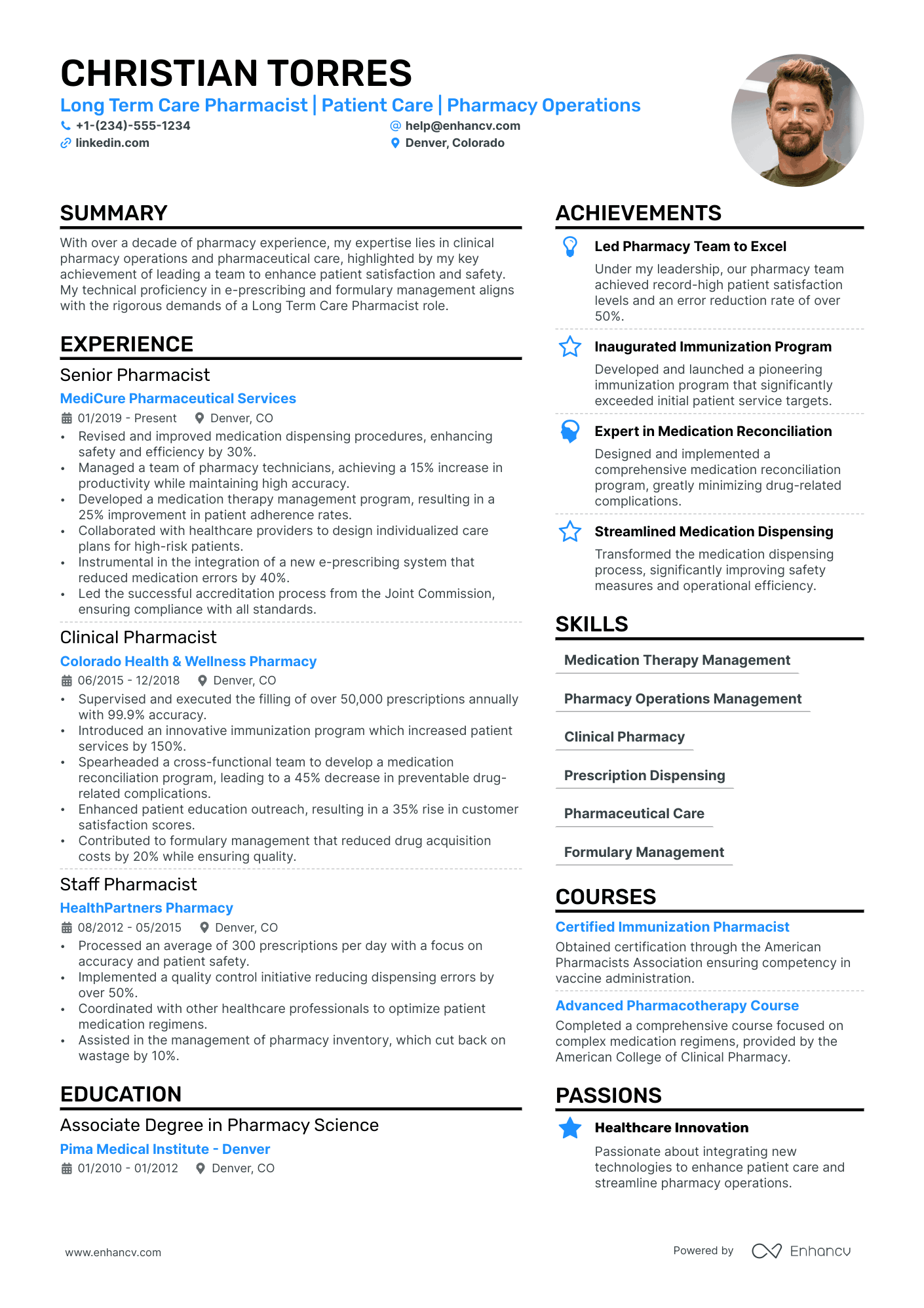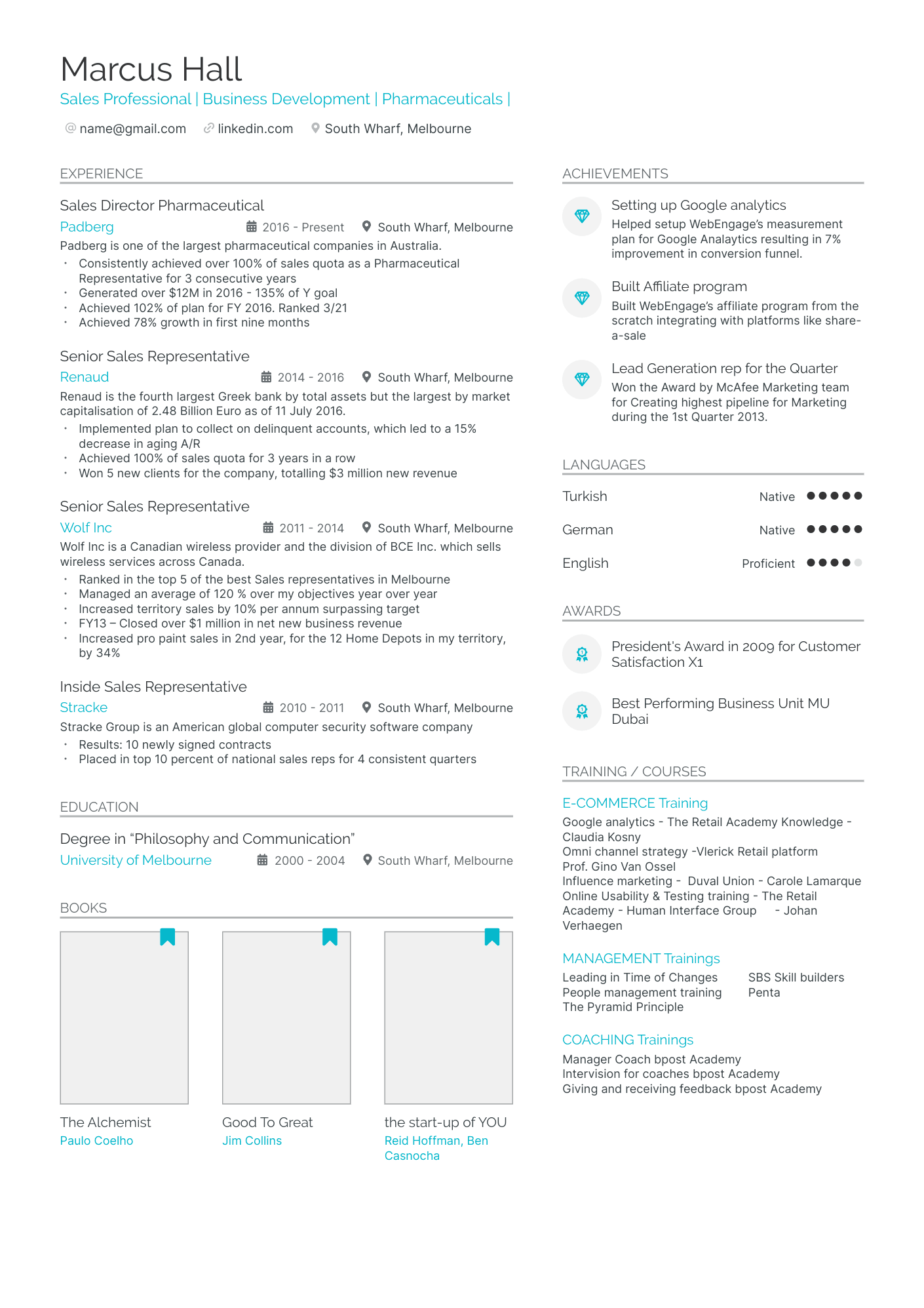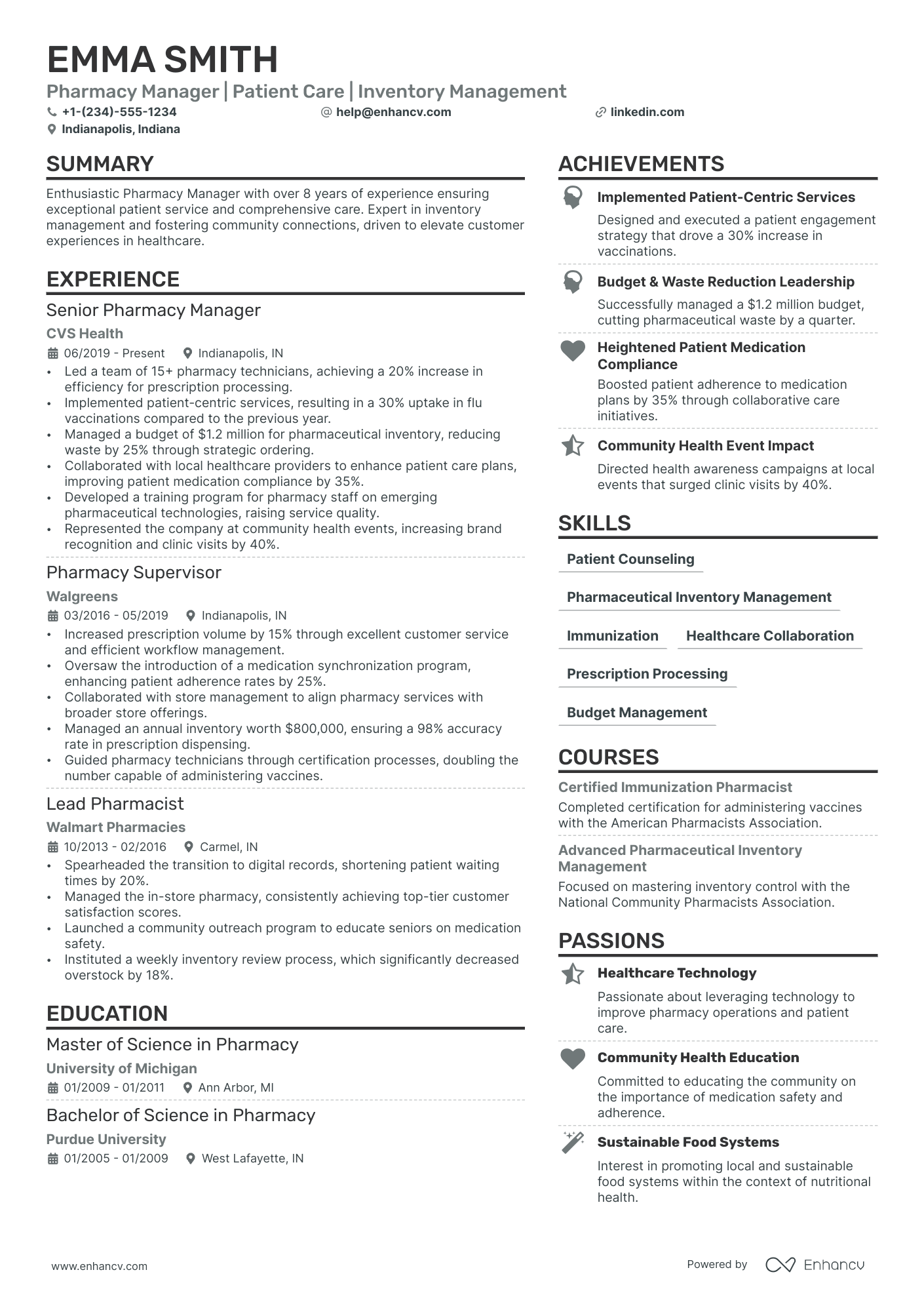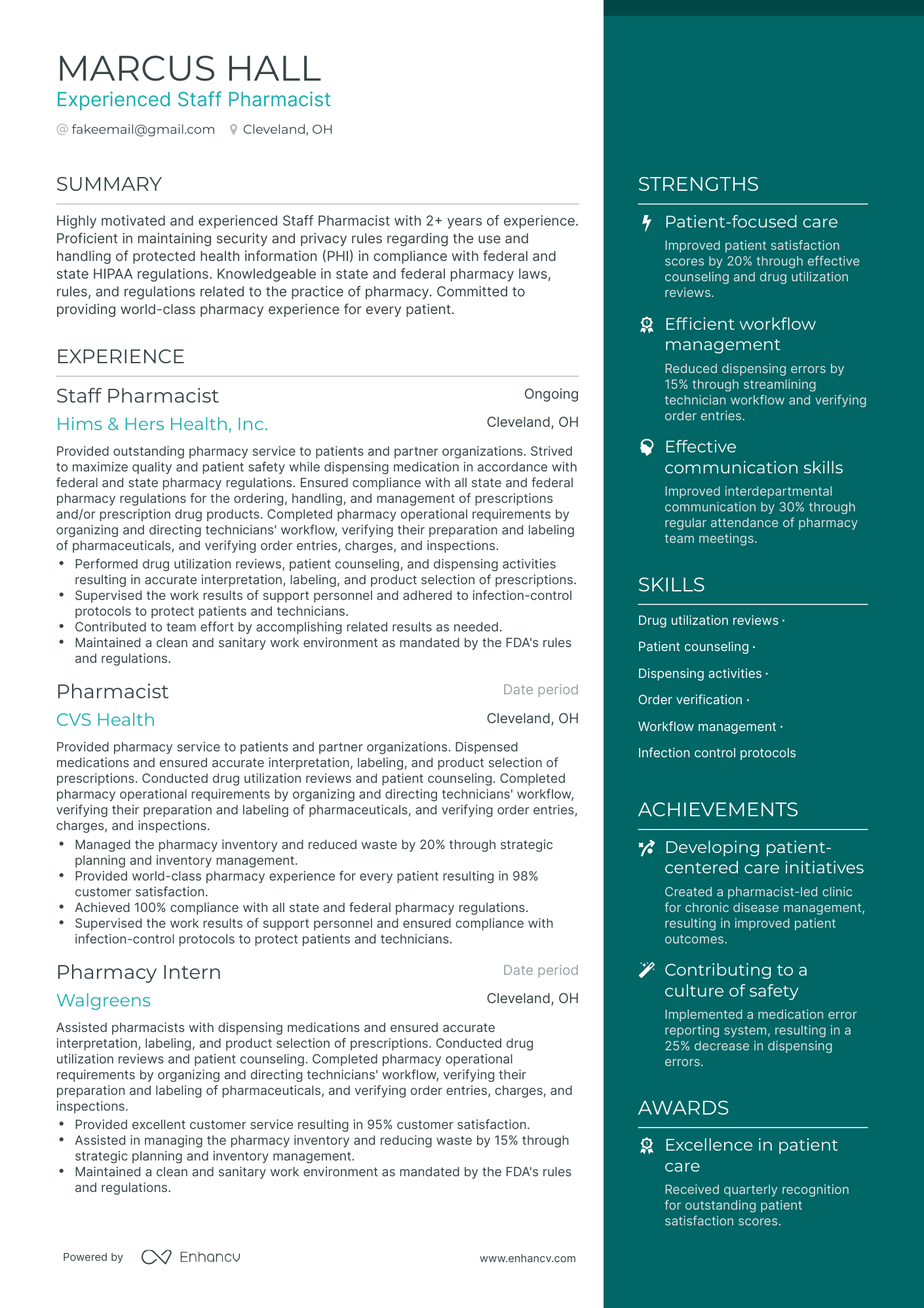Starting your journey as a pharmacist in 2024? With an average salary reaching over $150,000, it’s easy to see why this career is so appealing. But let’s be honest: it’s super competitive out there, and your resume has to be more than a list of achievements—it needs to sparkle! Highlight how you mastered your prerequisite courses, excelled in the Pharm.D. program, and aced the NAPLEX exam.
Every section of your resume should be a story of dedication and hard work. But in a field where everyone is aiming for the top, having a standout resume isn’t just a bonus—it’s essential.
We’ll help you create a resume that not only showcases your academic successes but also puts you in the spotlight for your next big opportunity. This pharmacist resume guide will cover:
- How to format a resume that passes the recruiting process with flying colors;
- How to list your experience in pharmacy and what to do if you’re only starting now;
- How to distill your education, certifications, and licenses into concise resume sections;
- How to support your entries with concrete data and how to target your resume to each specific job listing.
Before we dive in, we thought you might be interested in something more specific. Take a look at some other pharmacy-related resume guides here:
- Hospital Pharmacy Technician Resume
- Pharmacy Technician Resume
- CVS pharmacist Resume
- Retail pharmacist Resume
- Pharmacist Cover Letter
How to format a pharmacist resume that stands out
To get hired as a pharmacist, you need to convince the recruiter that you have what it takes to provide excellent patient care, dispense prescriptions accurately, and successfully sell OTC and Rx medications.
You are the key connection between doctors, patients, and insurance companies. The attentive care you have for your job directly contributes to the well-being of your patients. Pharmacists are essential, and employers take great care to hire the right person for the role.
Writing a stand-out pharmacist resume is the first step to building trust with the recruiter. Let’s begin with the resume format.
Use a reverse-chronological resume format to emphasize your experience and skills. Employers in healthcare prefer this type as it provides a clear progression of the candidate’s career, listing their most recent job first.
If you’re not so experienced or want to emphasize specific skills relevant to the job you're applying for, then try the functional resume which is organized around skill categories. Another direction would be to use the combination format, especially if you’re changing career paths within healthcare, as it will give a good view of both your experience and skills.
Regardless of the format, make sure your resume is clear, concise, and focuses on your achievements and the value you can bring to the employer.
Resume design and layout for pharmaceutical positions
Recruiters, who review countless resumes daily, want to be able to quickly scan a resume and tell if a candidate is right for the job. For this reason, a resume that aligns with the expected format is perceived as more clear and professional. After all, healthcare is a traditional field, and pharmacy directors prefer resumes that allow them to quickly find the information they need, such as education, licensure, and relevant experience.
Several key factors should guide you as you craft your pharmacist resume.
Professional template: If you’re not building your resume from scratch, choose a resume template that is organized and straightforward. This will save you time and make the selection process for recruiters easier.
Margins: Don’t try to shrink margins to fit more content. Reducing them below 1 inch will lead to a cluttered, overwhelming, and hard-to-read resume.
Fonts: Opt for professional fonts in the 10-12 pt range. Easily readable fonts are super important for ATS assessment. (By the way, Enhancv’s resume builder only uses fonts that are entirely ATS-friendly). For pharmacists, fonts like Rubik, Lato, or Arial meet the industry standard.
Length: Ideally, your resume shouldn’t exceed 1 page (2 pages for the highly experienced ones among you). A 1-pager is more likely to keep recruiters engaged.
Colors: Even though you’re part of a traditional industry, a splash of color creates contrast and hierarchy in the resume and thus directs attention to the key areas. Green is associated with the health industry, so you can safely use it as the primary color for the section titles.
Naming: When naming your file, write your name, followed by the job title you are applying for, and then the word “resume” (e.g., JaneDoe_pharmacist_resume.pdf). Always save your document as a PDF to ensure it's accessible across all devices and platforms.
Header: A compelling header is crucial in making that first impression memorable, so remember to include a descriptive job title and your contact information (email, phone number, and LinkedIn URL).
Is your resume good enough?
Drop your resume here or choose a file. PDF & DOCX only. Max 2MB file size.
Here are the other resume sections that a pharmacist should feature on their resume.
The top sections on a pharmacist’s resume
- Professional license and certifications to validate credentials and expertise.
- Pharmaceutic skills, highlighting specific areas of proficiency.
- Relevant pharmaceutical experience that demonstrates practical application of skills.
- Continuing education and training, showing commitment to staying current in the field.
- Patient care and counseling skills, emphasizing the ability to provide patient-focused care.
Deciding on the organization of the resume sections is largely dependent on the job you’re applying for. Carefully research the employer and the job description to find the key competencies and the keywords that you’ll later include in your resume. Below is the information that your resume should provide.
What recruiters want to see on your resume
- Active pharmacy license: Essential for legal practice and ensures compliance.
- Experience in medication therapy management: Demonstrates ability to optimize patient care.
- Proficiency in pharmacy management systems: Shows capability to efficiently handle pharmacy operations.
- Knowledge of pharmacology and drug interactions: Critical for patient safety and effective treatment plans.
- Customer service and communication skills: Vital for patient education and building trust in healthcare settings.
Now, let’s focus on the resume experience section as it is where recruiters investigate whether you have the qualifications and skills needed for the role.
How to write your pharmacist resume experience
The experience section should reflect what the employer is specifically looking for. All of this information can be found in the job description. So, to stand out and avoid being generic, touch on exactly the same competencies from the job listing and support them with quantifiable results and achievements.
For example, did you manage a pharmacy team? How many people? Did you improve processes and see a noticeable difference in efficiency? By what percentage?
This is your time to convince the recruiter that you stand apart from the other applicants. Let’s explore two examples of an experience section to see what works best for a pharmacist’s resume.
- •Administered medications.
- •Educated patients on dosages and instructions.
- •Maintained patient records.
- •Delivered excellent customer service.
This experience section is way too vague. It doesn’t set the candidate apart from any other resume in the pile.
Let’s look at a better example.
- •Delivered excellent customer service, achieving a 4.8 average pharmacy rating.
- •Administered 200+ COVID vaccinations per day—the highest in the province.
- •Increased revenue by 20% in 2021 by improving automatic patient follow-up system and delivering refills.
- •Experienced in methadone pain management strategies after completing the CAMH Opioid Use Disorder Treatment Course.
Here, the candidate makes sure they qualify each statement with concrete data.
- Specific title: Specifying the role (retail pharmacist) is a good keyword strategy, as it directs the recruiter’s attention to what they’re looking for. Plus, it takes the candidate out of the “generalist” box.
- Quantifiable achievements: By including specific figures, such as a 4.8 average pharmacy rating and administering 200+ COVID vaccinations per day, the candidate demonstrates their impact and success.
- Revenue growth: Highlighting a 20% increase in revenue showcases the pharmacist's direct contribution to the business's financial success and indicates a strong understanding of pharmacy operations.
- Specialized skills: Mentioning experience with methadone illustrates specialized knowledge and commitment to addressing complex health issues.
- Customer service excellence: Commitment to delivering excellent customer service is proven by a high pharmacy rating, which indicates the pharmacist's ability to ensure patient satisfaction and build trust.
To achieve something similar, just follow the steps we give you in the following passage.
How to quantify impact on your resume
Your resume should be specific, it should highlight real achievements, and showcase a mix of technical and soft skills. If you’re a pharmacy manager, you also need business know-how. So, your most crucial job when building a resume is to provide clear evidence of your training and expertise. Use the following list as a starting point.
- Include the percentage increase in pharmacy revenue under your management to demonstrate business growth and your direct impact.
- Mention the number of prescriptions filled per day to highlight your efficiency and capability to handle high-volume workloads.
- State the percentage reduction in medication errors due to initiatives you implemented, showcasing your commitment to patient safety and quality care.
- Detail the number of healthcare professionals you've collaborated with on multidisciplinary teams to illustrate your teamwork and communication skills.
- List the number of patient counseling sessions conducted to emphasize your dedication to patient education and health outcomes.
- Specify the increase in customer satisfaction scores or pharmacy ratings to reflect your ability to provide excellent customer service.
- Report the percentage of inventory reduction while maintaining or improving service levels, showing your ability to manage resources effectively.
- Describe the number of new services you introduced, proving your innovation and contribution to expanding the pharmacy's offerings.
Think in facts and figures even if you have no experience working in a pharmacy yet. Read on to learn more about that.
How do I write a pharmacist resume with no experience
Everyone has to start somewhere. Even junior pharmacists who have spent the past 6-7 years of their lives in prerequisite coursework, training, and licensing.
The following guidance is for entry-level positions or pharmacists making a career transition within the field.
PRO TIP
If you have 0-3 years of experience in pharmacy, you should write a resume objective rather than a career summary. It’s more concise and shows your alignment with the prospective employer’s mission and values.
- Create a strong education section. It has to detail your bachelor’s or pre-pharmacy program, your Doctor of Pharmacy degree (PharmD), and your NAPLEX and MPJE scores.
- Focus on certifications (even if they’re pending). This is a great opportunity to mention the specialty you’re pursuing, such as oncology, diabetes, or First Aid.
- Mention any internship or residency roles. Detail the in-field experiences you've had during your education. Include the location, your role, and key responsibilities or achievements. This section provides insight into your practical experience and application of pharmacy knowledge. (We explore this in further detail at the end of the article).
- Highlight relevant skills. Focus on both technical skills (e.g., knowledge of pharmacological databases, drug dispensing) and soft skills (e.g., communication, customer service, ability to work under pressure) that are valuable in a pharmacy setting.
- Show your initiative. Include any volunteer work or extracurricular activities, especially those related to healthcare or community service, that demonstrate your leadership skills, teamwork, and dedication to helping others.
Remember, your resume is your chance to tell a story about your journey starting in pharmacy. You've already spent significant amounts of time and money on training and licensing. Now, you only need to show that you're ready to tackle the challenges ahead with enthusiasm and expertise.
How to list your hard and soft skills on your resume
pharmacists need to show both hard and soft skills on their resumes. Hard skills cover the technical aspects of being a pharmacist—the skills you learned in school and your rotations. These could range from experience in an area of medicine like nephrology or oncology, to knowing your way around specific software or workflow, like Fillware.
Best hard skills for a pharmacist resume
- Prescription dispensing and review
- Pharmacology expertise
- Medication therapy management (MTM)
- Drug utilization review (DUR)
- Immunization and vaccination administration
- Pharmaceutical calculations
- Compounding techniques
- Inventory management systems
- Patient record management software
- Pharmaceutical research and development
- Clinical pharmacokinetics
- Aseptic technique for sterile compounding
- Regulatory compliance (FDA, DEA)
- Drug interaction and contraindication analysis
- Pharmacy information systems (e.g., Epic, Cerner)
- Automated dispensing technology
- Health insurance and billing practices
- Pharmacogenomics
- Chemotherapy drug preparation
- Opioid dispensing and control measures
Soft skills are the personality traits that make you great at patient care and working with a team. Below is a list of the top interpersonal skills that a pharmacist needs to demonstrate on their resume.
Best soft skills for a pharmacist resume
The easiest way to write a skills section is to first read the employer’s job description. Note down the keywords they use when describing their ideal candidate, or the responsibilities of the role. Use those same keywords in your skills section.
How to put certifications and education on a pharmacist resume
Education is essential for a pharmacist and should have its dedicated section on your resume. However, it can be confusing to decide how much information to include. It very much depends on if you’re fresh out of college, or an experienced pharmacist looking for a new role.
If you’re entry-level, your education section can and should include more detailed information to make up for lack of experience. In this case, include:
- Your undergraduate degree and college name;
- Your PharmD degree and college name;
- Years studied;
- GPA grade;
- Any notable coursework, recognition, or awards;
- Residency rotations.
- •Completed a rigorous curriculum focused on pharmaceutical sciences, patient care, and pharmacy management.
- •Engaged in advanced pharmacy practice experiences (APPEs) across multiple settings, including community pharmacies, hospitals, and ambulatory care clinics.
- •Conducted a capstone research project on the impact of medication therapy management on patient outcomes in cardiovascular diseases.
- •Participated in professional development workshops, enhancing communication, leadership, and clinical decision-making skills.
If you’re a seasoned pharmacist, include all of the above, but drop the GPA, notable coursework, recognition or awards, and your rotations. Your actual career accomplishments hold more weight.
Licenses and certifications for pharmacists
Just like with education, a separate licenses and certificates section is essential for pharmacist resumes.
Every job will require you to be licensed with your state or province. List your license name, state or province, license number, and active dates.
Then, review the job description to see what certifications the employer is looking for. Some will be required and others will be an asset. If you have them, prioritize those first before providing other certifications.
Here’s a list of common certifications and licenses in the pharmaceutical industry:
Best certifications for your pharmacist resume
After detailing your experiences and certifications, revisit your summary at the resume’s beginning. It’s time to condense your strengths and accomplishments into a concise, impactful summary of no more than five sentences.
How to write your pharmacist resume summary or objective
Both the career summary and the objective statement should reflect your professional aspirations and core values, presenting a clear, engaging overview of what you bring to potential employers. Still, the resume objective is shorter and more suitable for novice pharmacists, as discussed previously, while the summary is for people with extensive experience.
Generally, a resume summary should help the prospective employer find the key skills and competencies they’re looking for in a candidate. This is why it’s important to study the job description carefully before writing your summary and adapting it for each application.
Let’s consider the examples below, a good and a bad one, to analyze the features of an effective summary.
This summary will get the resume into the rejection pile. It’s way too vague and doesn’t convince anyone that you’re a trustworthy professional.
Why it’s good:
- Quantifiable achievements: The summary showcases specific, measurable accomplishments such as increasing prescription accuracy by 30% and improving customer satisfaction scores by 25%, which highlight the candidate's direct impact on operational success.
- Leadership and management skills: It emphasizes the candidate's ability to lead and develop a team, showcasing leadership skills.
- Expertise in the field: Demonstrates deep knowledge and expertise in pharmaceutical operations and healthcare management, evidenced by the successful implementation of an innovative inventory system that reduced waste by 20%.
- High-level professionalism: The use of the first-person narrative conveys seniority and authority. Coupled with the highly professional language, the choice of words adds to the candidate’s credibility.
- Future-focused and motivated: The candidate expresses a commitment to excellence and innovation, with a clear intention to leverage their extensive background to further improve health outcomes and operational efficiency.
If you want your resume summary to truly shine, consider using our AI-powered resume checker which can proofread your content and save you the stress.
Additional sections for a pharmacist resume
For a pharmacist’s resume, adding sections that highlight your specialized skills, experiences, and achievements can make a big difference in showcasing your qualifications. Here are some common additional resume sections that pharmacists often include:
- Professional affiliations: Membership in professional organizations such as the American pharmacists Association (APhA) or the American Society of Health-System pharmacists (ASHP) demonstrates your commitment to the profession and ongoing education.
- Publications: If you have authored or co-authored research papers, articles, or textbooks related to pharmacy or medicine, listing them can add significant value to your resume.
- Awards and honors: Include any recognition you've received for your work in pharmacy, such as excellence awards, scholarships, or accolades from professional associations.
- Conferences and workshops: Participation in industry conferences, workshops, and seminars can be listed to show your engagement with the pharmacy community and your effort to keep up to date with new developments.
- Professional references: While not always listed directly on the resume, having a section ready upon request can be beneficial, especially references from the pharmaceutical field.
Tailor these sections to fit your individual experiences and the specific job you're applying for. This can significantly enhance your resume's impact.
How to put internships in a pharmaceutical resume
The main goal of additional sections in a resume is to showcase your practical experience in the field and highlight your commitment and hands-on skills in various pharmacy settings. Many aspiring pharmacists dedicate a section to their residency or internship roles because internships provide opportunities to build professional relationships and receive mentorship from experienced healthcare professionals.
Here’s what you need to know when building an internship/residency section:
- An internship section should look like the experience section of a resume, mentioning the workplace, dates, and at least 3 bullet points with your contributions.
- Write your internship experience separately only if you lack other professional experience. If you’re no longer ‘junior,’ the internship should be listed in the experience section.
- When listing your entries, ensure you provide concrete evidence of your accomplishments to clearly demonstrate your impact and skills.
Here’s a good example of a detailed residency section entry on a pharmacist’s resume:
- •Implemented medication therapy management protocols, improving patient adherence by 25%.
- •Led a cross-functional team in a QI project that reduced medication errors by 15%.
- •Developed and delivered educational presentations on drug interactions to healthcare staff, enhancing the overall safety of medication administration.
Key takeaways
Before you proceed to manage dosages and dispense life-saving medications, let's review the key points to remember when crafting your pharmacist resume. In today's article, we've covered how to:
- Format a resume that gives justice to both your skills and professional experience.
- List career successes by supporting them with concrete facts and figures.
- Choose which skills to include in your resume and where to list them, so that recruiters get a clear picture of your profile.
- Write about your education, training, and certifications in a concise but effective way.
- Learn strategies to enhance your experience section by using the right metrics, not just listing your job responsibilities.
Pharmacist resume examples
Explore additional pharmacist resume samples and guides and see what works for your level of experience or role.
By Role
